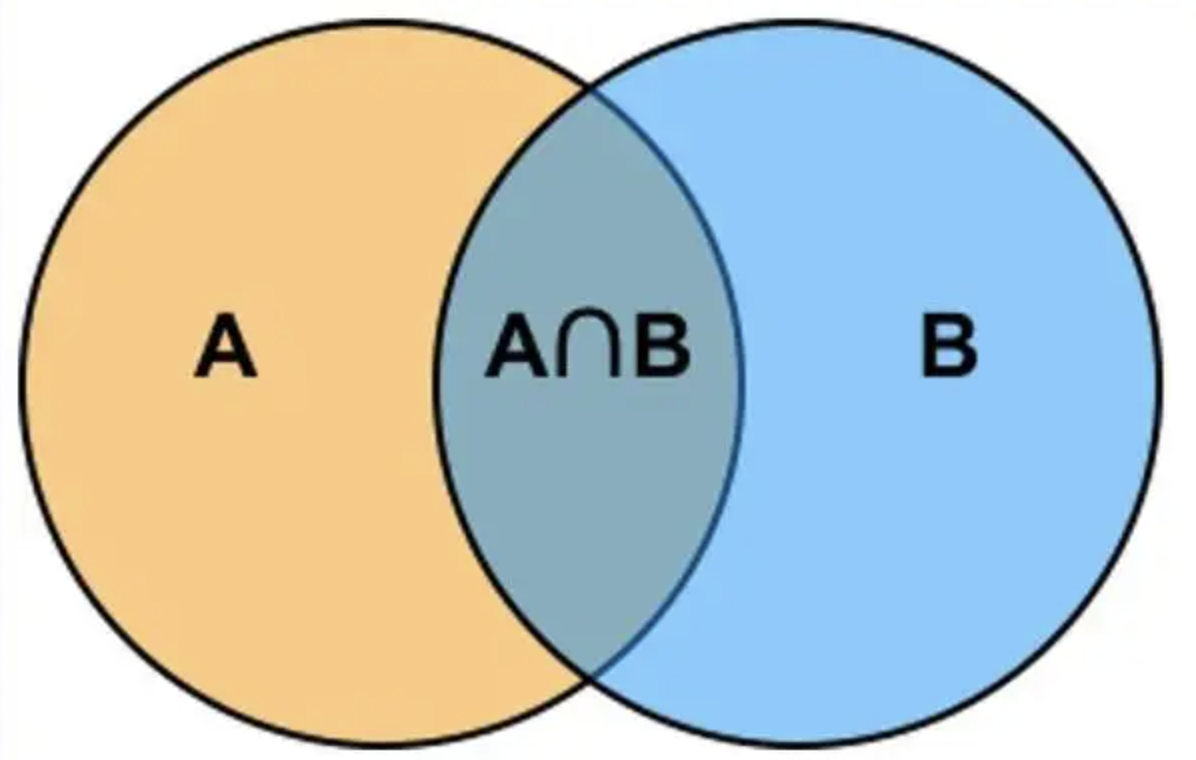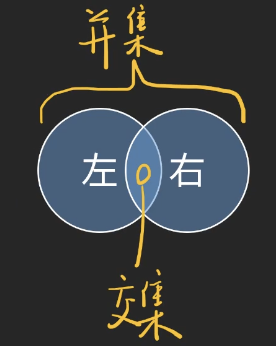JS可以对值进行加减运算,如果把TS的类型系统当作一门语言,TS可以对类型进行各种运算。TS就相当于JS + 类型系统。
TS的类型系统有哪些运算?
联合类型(并集union types)
并集案例:
type A1 = number
type B1 = string
type C1 = A1 | B1
const c1:C1 = 42
type A2 = { name: string }
type B2 = { age: number }
type C2 = A2 | B2
const c2:C2 = {
name: 'John',
age: 18
}
C1的类型范围及为A1和B1两者的并集,即上图的A圈和B圈的内容。
使用typeof区分类型
这种不断通过if语句进行typeof类型判断,来断定值属于那个类型,这也叫类型收窄(Narrowing)。
const f1 = (a: number | string) => {
if (typeof a === 'number') {
a.toFixed(2)
} else if(typeof a === 'string') {
parseFloat(a).toFixed(2)
} else {
throw new Error('Never do this')
}
}typeof的局限性
只能返回类型的字符串,且就只有这几种类型,对于数组类型、普通对象、日期对象、null,这些返回的都是**"object"**。
typeof x可以推断类型的字符串,具体类型如下所示:
- "string"
- "number"
- "bigint"
- "boolean"
- "symbol"
- "undefined"
- "object"
- "function"
使用instanceof来区分类型
instanceof以对象的类为主。也叫类型收窄(Narrowing)。
instanceof后面只能接一个class。
const f1 = (a: Array<Date> | Date) => {
if (a instanceof Date) {
a.toISOString()
} else if () {
a[0].toISOString()
} else {
throw new Error('Never do this')
}
}instanceof的局限性
- 不支持string、number、boolean...这些简单类型判断。
- 不支持TS独有的类型(会被擦除的类型)。
type Person = { name: string }
// type 不能用作 value
const f1 = (a: Person) => {
if(typeof Person) {
// 'Person' only refers to a type
// , but is being used as a value
}
}如何解决typeof和instanceof都不能用的情况,使用in
使用in来收窄类型,只适合普通对象(部分对象)。
type Person = {
name: string
}
const f1 = (a: Person | Person[]) => {
if ('name' in a) {
a // Person
} else {
a // Person[]
}
}使用JS中判断类型的函数来区分
const f1 = (a: string | string[]) => {
if (Array.isArray(a)) {
a.join('\n').toString()
// 此处a的类型是 string[]
} else if (typeof a === 'string') {
parseFloat(a).toFixed(2)
} else {
throw new Error('Never do this')
}
}此方法的局限是TS的类型还是会被擦除,用的是JS的逻辑来判断TS的逻辑,这是两门语言,并不能一一对应。
TS能够推断的情况是会自动给推断的,TS收窄文档Narrowing。
const f1 = (a?: string[]) => {
if (a) { a // string[]
} else { a // undefined
}
}
const f2 = (a: string | number) => {
a = 1 // a 为number
}
const f3= (x: string | number,y: string | number) => {
if (x === y) {
x // string
y // string
} else {
x // string|number
y // string|number
}
}以上的收窄都是通过JS实现,有没有区分类型的万全之法呢?
is 类型谓词/类型判断
type Rect = { hegiht: number; width: number }
type Circle = {
center: [number, number]; radius: number
}
// 只能为function 函数 箭头函数会报错
function isRect(x: Rect | Circle): x is Rect {
// x is Rect 为什么不写bool
return 'height' in x && 'width' in x
}
function isCircle(x: Rect | Circle):x is Circle {
return 'center' in x
}
const f1 = (a: Rect | Circle) => {
if (isRect(a)) { // isRect 判断a是不是Rect
a // Rect
} else {
a // Circle
}
}is也相当于一种断言,但是是在运行后。
函数的返回类型不写bool值呢?这样写的话函数的返回值的类型是boolean,它可以是true或者false。
is的优点:支持所有TS类型
is的缺点:麻烦,需要声明函数,声明返回值的类型。
定义可辨别联合属性x.kind
多定义一个属性来定义名称一般用kind、cate,属性名叫做可辨别联合(Discriminated Unions)。
type A = {
kind: 'A'; value: number
}
type B = {
kind: 'B'; value: string
}
const f1 = (a: A | B) => {
if (a.kind === 'A') {
a // A
} else if (a.kind === 'B') {
a // B
} else {
a // never
}
}interface Circle {
kind: "circle"; radius: number
}
interface Square {
kind: "square"; sideLength: number
}
type Shape = Circle | Square
const f1 = (shape: Shape) => {
if (shape.kind === 'circle') {
shape // Circle
} else if (shape.kind === 'square') {
shape // Square
} else {
shape // never
}
}优点:让复杂类型的收窄,变成简单类型的对比。
要求:T = A |B|C|D|...
- A、B、C、D....有相同属性kind或其它。
- kind的类型是简单类型。
- 各类型中的kind无区分。一句话总结:同名、可辨别的简单类型的key。
符合以上三种要求,则可称T为可辨别联合。
类型收窄总结
- JS方法:typeof x...
- TS方法:is
- TS方法:x.kind
- TS方法:断言(使用as)
交叉类型(交集itersection types)
// 简单案例
type A = string & number
// ^-- never
type 有左手的人 = {
left: string
}
type 有右手的人 = {
right: string
}
type C = 有左手的人 | 有右手的人
type D = 有左手的人 & 有右手的人
const d: D = {
// ^-- 'right' is missing
left: 'yes'
}
type
type 有左手的人 = { left: string}
const b = {
left: '一米八',
right: '一米五'
}
const a: 有左手的人 = b
const a2: 有左手的人 = {
left: '一米八',
right: '一米五'
// ^-- error
}左边的案例,可以得出初始化的时候不能有多余的东西。这是因为TS有的时候松有的时候严格,所以可以发现const a: 有左手的人 = b,a可以被赋值且不会发生报错,而通过定义好类型后再去赋值添加多余的东西则会报错。
交集不仅能用在type,接口interface也能求交集。
interface Colorful {
color: string
}
interface Circle {
radius: number
}
type ColorfulCircle = Colorful & Circle还可以模拟继承
type Person = {
name: string
age: number
}
type User = Person & {
id: number
email: string
}
const u: User = {
name: 'baizhe', age: 18, id: 1,
email: 'xxxx@qq.com'
}错误的情形:
type Person = {
name: string
age: number
id: string
}
type User = Person & {
id: number
email: string
}
// 尝试同名覆盖,属性冲突了但未报错。
const u: User = {
id: 1, // never
name: 'baizhe', age: 18,
email: 'xxx@qq.com'
}
const a: User = {
email: 'x',
name: 'frank',
id: (1) as never // 强制为 never 奇妙的方法 断言为 never类型
}
console.log(a.id) // never
// 另一种情况
type A = { kind: 'A', name: string }
type B = { kind: 'B', age: number } & A
// ^-- neverinterface和type的另一个区别
遇到属性冲突时,interface直接报错,type会直接never。能够对外提供的接口拓展性强一些。
interface Person {
name: string
age: number
id: string
}
interface User extends Person {
// ^-- 'number' is not assignable to 'string'
id: number
email: string
}type A = {
kind: 'A',
name: string
}
type B = {
kind: 'B',
age: number
} & A两个函数求交集会得到并集如下面代码所示,这是因为TS会进行递归的交集,但是函数的交集会得到一个参数的并集。
type A = {
method: (a: number) => void
}
type B = {
method: (a: string) => void
}
const b: B = {
method(a) {
a // number | string
}
}
// 另一种案例
type F1 = (n: number) => void
type F2 = (n: string) => void
type X = F1 & F2
const x: X = (n) => {
// number | string
console.log(n)
}**结论:**交叉类型常用于有交集的类型A、B,如果A、B无交集,可能得到never,也可能只是属性为never。
思考题
- any = 所有类型的联合?为什么?(除了 never/unknow/any/void),具体见TS文档。
可以理解为 any = 法外狂徒张三,TS绝大部分规则对any不生效。type any = noErrorType。
type unknow = 所有类型联合,用反证法可以证明,但联合之后有些不能用了。
const f1 = (a: string | number) => {
a.split()
}
const f2 = (a: any) => {
a.toFixed()
a.split()
}
//
const f3 = (a: any) => {
const b: never = a //errors
}- 什么 = 所有类型的联合(除了 never/unknow/any/void),为什么?
是unknown。必须收窄类型去使用。举例如下所示。
const f1 = (a: unknow) => {
if(a instanceof Date) {
a // Date
}
}
const f2 = (a: unknow) => {
if(isPerson(a)) {
a // Person
}
}